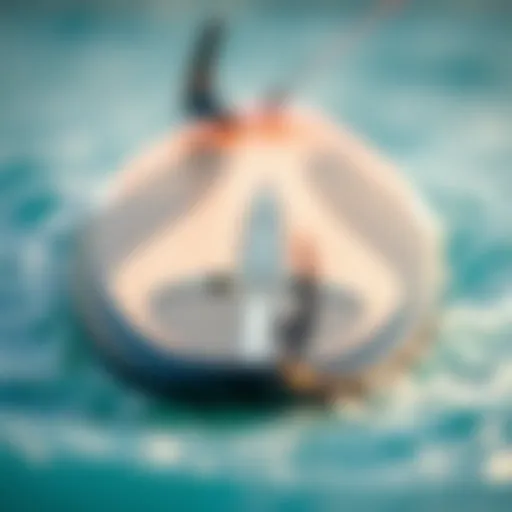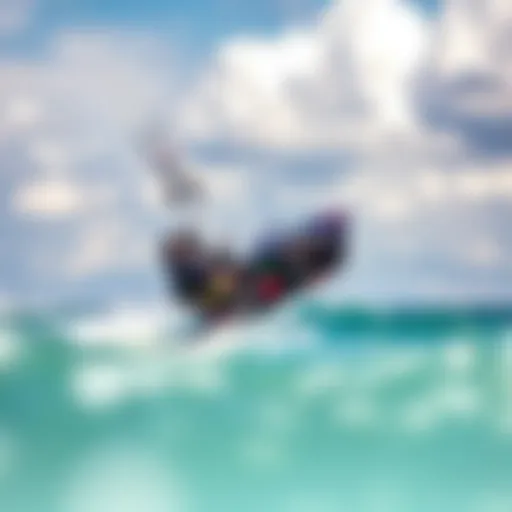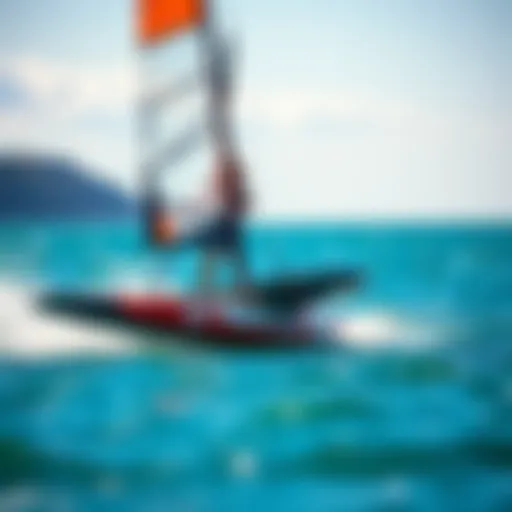Elevate Your Kiteboarding: Jumping Techniques and Tips
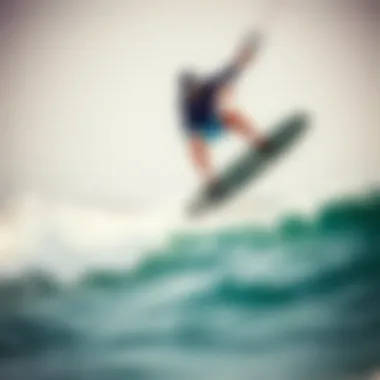
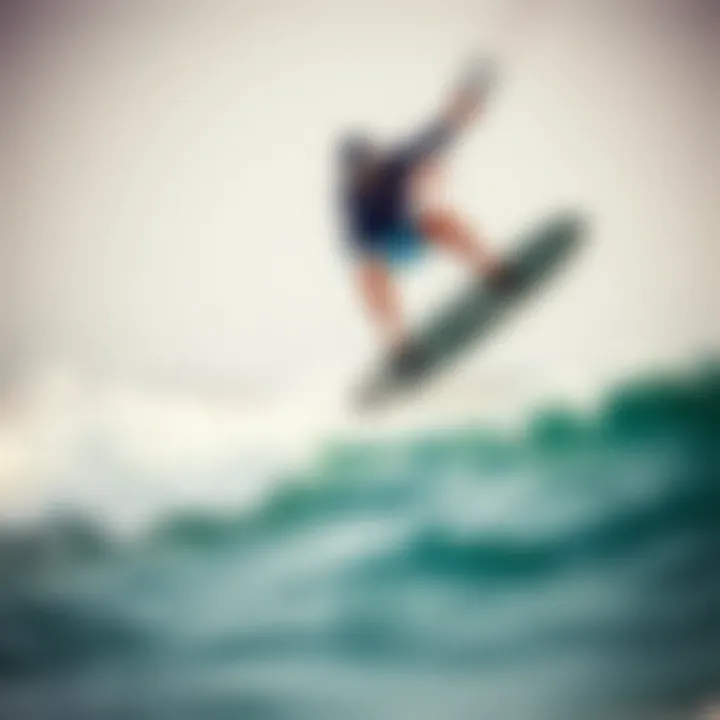
Intro
Kiteboarding offers an exhilarating experience, blending the thrill of surfing with the adventures of aerial maneuvers. As riders take to the air, understanding the techniques and strategies to enhance their jumping ability can make all the difference between an exhilarating leap and a hard landing.
Whether you're just starting out or have been carving the waves for years, knowing how to optimize your jumps is crucial. Not only does jumping higher enhance your overall performance, but it also significantly improves your control during aerial tricks. This article promises to dissect the essentials, breaking down the components needed for mastering this facet of kiteboarding.
We’ll explore various methods to develop your jumping abilities while keeping safety at the forefront. By examining everything from fundamental jumping techniques to specific board and kite reviews, we'll equip you with the tools necessary for successful harnessing of the wind and waves.
Additionally, throughout this discussion, look for insights on cutting-edge equipment and exercises tailored to skyrocket your performance. If you're ready to take your kiteboarding skills to new heights, read on.
Physical Conditioning for Jumping Higher
Physical conditioning is a cornerstone for kiteboarders looking to enhance their jumping ability. To jump higher means not only harnessing the wind but also developing the right physical attributes. When you think about jumping, it’s tempting to imagine just the thrill of the air beneath your feet, but the reality is much more grounded. Improving your physical strength, flexibility, and endurance lays the foundation that allows you to take full advantage of your equipment and the wind conditions.
Furthermore, a well-conditioned body minimizes the risk of injuries, which can sideline any rider looking to progress. By focusing on specific training methods, kiteboarders can unlock their full potential, making jumps not just higher but more controlled and dynamic.
Importance of Strength Training
Strength training is like the bread and butter of any kiteboarder's fitness routine. It's crucial for providing the muscle power required to spring off the water effectively. When you strengthen muscles in your legs, core, and back, you're not just aiming for aesthetics; you're building the power needed for those explosive jumps.
Lifting weights or using resistance bands will help improve your overall strength, which translates to better takeoff and landing. Not to mention, stronger muscles help prevent fatigue during prolonged sessions on the water. Since kiteboarding often demands sudden bursts of energy, being strong decreases the risk of injuries that come from fatigue.
"A strong body can better manipulate the kite and board, making precision jumps within reach."
Key Muscle Groups to Target
To boost your jumping ability, it’s essential to focus on certain muscle groups:
- Legs: The quadriceps, hamstrings, and calves are fundamental for creating the upward force during takeoff. Exercises like squats, lunges, and box jumps can help develop explosive power.
- Core: Your core stabilizes your body during jumps and maneuvers. Planks, Russian twists, and other core exercises offer greater stability in the air.
- Back: A strong back supports the body as you maneuver through the air. Think rows and deadlifts to build that strength.
While it’s important to work on these specific groups, don’t neglect your upper body—shoulders and arms play a role in controlling the kite while airborne.
Incorporating Functional Movements
Functional movements mimic the real-life actions involved in kiteboarding. These exercises help in not just building strength but also enhancing body coordination and balance. Using movements that require multiple joints and muscle groups will prepare your body more effectively for the demands of kiteboarding.
A few examples of functional exercises that can be integrated into your routine include:
- Kettlebell Swings: Improve explosive hip extension, a critical movement for jumping.
- Burpees: Great for building stamina while incorporating strength and explosiveness.
- Medicine Ball Slams: Engage multiple muscle groups while simulating the action of pulling on the bar during takeoff.
By including these movements in your training regimen, you’re setting yourself up to not just jump higher but to do so with better stability and control. This comprehensive approach allows kiteboarders to fully benefit from their sessions on the water.
Understanding Kite Dynamics
Understanding kite dynamics is a cornerstone of elevating your kiteboarding skills, particularly when it comes to jumping higher and more efficiently. Kiteboarding relies heavily on the interplay between the wind, your kite, and the various maneuvers you execute. By getting a handle on the specifics of how kites function—specifically lift, drag, and the angle of attack��—you can start to harness the power of the wind to your advantage.
The manipulation of kite dynamics is what separates an average rider from an exceptional one. Learning to read environmental cues and adjusting your kite’s behavior accordingly is vital for maximizing jump height and enhancing aerial control. By mastering the principles of lift, drag, and line tension, you can ensure that you're not just getting air but doing so in a way that's controlled and responsive.
Kite Lift and Drag
Lift is the force that propels your kite upward, while drag is the opposing force that resists its movement. Grasping these concepts can determine how high you can jump. When you pull on the control lines or adjust your kite’s angle, you’re altering the balance between these forces.
- Lift is increased by:
- Drag can be minimized by:
- Angle of Attack: The angle at which the kite meets the wind. A higher angle can lead to more lift but also increase drag.
- Wind Speed: The more consistent and strong the wind, the greater the lift potential.
- Streamlined Shape: A well-shaped kite cuts through the wind with ease, minimizing drag.
- Proper Line Length: The right length helps maintain optimal angles, reducing unnecessary resistance.
Understanding how to maximize lift while minimizing drag allows for higher jumps and better control during your descent.
Adjusting Line Tension
Line tension can make or break a jump. Too much slack can render your kite unresponsive, while too little can lead to stalling or overstressing the kite during maneuvers.
- Finding Balance: The key is to adjust your line tension continuously. When you're preparing for a jump, slightly increasing tension can help you catch the wind more efficiently. Monitor your kite closely; if you notice it drooping or failing to catch air, it may be time to work on adjusting those lines accordingly.
- Before the Jump: Tension increases as you prepare to leap, ensuring your kite is responsive.
- During Flight: Gradually releasing tension can allow for greater control as you navigate through aerial maneuvers.
Optimizing Kite Angle
Kite angle directly influences the performance of your leaps. Finding that sweet spot where you can take advantage of both lift and minimal drag is essential.
- Feed into the Wind: A proper angle places the kite almost directly into the wind, allowing for maximum lift.
- Adjusting During the Jump: Shifting the angle slightly as you lift off can lead to better aerial control, allowing you to tuck in or spread out as needed.
To jump effectively, understand that kite dynamics are not static—they change with the wind conditions, your position, and even your skill level. Being adaptable can make all the difference.
Takeoff Techniques
Takeoff techniques are the very foundation for executing epic jumps in kiteboarding. Mastering these skills is essential if you want to soar higher, perform dynamic tricks, and make your landings smooth as silk. Proper takeoff ensures you capitalize on the kite's lift, ultimately unlocking your potential to achieve greater heights and greater freedom in the air.
Timing the Jump
Timing is everything in kiteboarding. It’s the difference between a lift-off that leaves you hanging in the air and a miscalculated leap that has you kissing the water. To get it right, you need to be in sync with both the kite and the wind. When approaching for a jump, it's vital to note the kite's position.
- Wait for the Right Moment: You should initiate your jump when the kite is at its apex. This is typically when the kite is just overhead or slightly ahead of you (around the 12 o'clock position).
- Feel the Pull: As you ride upwind, that force from the kite creates tension. The moment you feel that power peak, it’s your cue to jump.
- Combine with Your Motion: Timing your jump with your board’s motion can amplify the lift. As you bear down against the water, jumping just as you push off will provide that extra boost.
"Every jump is a dance with the wind; timing is your partner."
Body Positioning
Your body position while taking off can either make or break a jump. It’s all about aligning yourself perfectly to harness the kite’s lift while maintaining balance. Proper body positioning helps in both gaining height and controlling your descent.
- Stay Centered: Keep your weight centered over the board. Leaning too far back or forward can throw off your balance, leading to less control.
- Bend Your Knees: A slight bend in your knees allows better absorption of the force during takeoff. Think of it as coiling a spring—ready to unleash power as you leap into the air.
- Engage Your Core: A strong core helps maintain stability not only while you jump but also throughout your aerial maneuvers. This stability is crucial, especially as you attempt to tweak your tricks in mid-air.
Utilizing Wind Power Effectively
Knowing how to harness wind power can redefine your jumping game. Kiteboarding is heavily reliant on the wind, and understanding its nuances can give you the edge you need.
- Angle of Attack: The angle at which your kite meets the wind considerably impacts lift. Aim for a shallower angle as you take off to increase the lift generated at the start.
- Use the Wind Window: Every kiteboarder should develop an instinctive understanding of the wind window. Positioning the kite on the edge of this window before a jump will generate maximum lift just as you take off.
- Utilize Gusts: Pay attention to gusts and shifts in wind. If you catch a gust just before launching, it can propel you higher than expected. Stay alert to these shifts; they can make all the difference.
In summary, mastering takeoff techniques is crucial for elevating your kiteboarding experience. The timing of the jump, your body positioning, and effectively utilizing the wind are essential elements that contribute to improved performance and higher jumps. With practice, make these techniques a part of your routine, and you’ll soon see the difference on your next ride.
For more info on techniques, consider checking resources on kiteboarding from sources like Wikipedia or Reddit.
Focus on Landing Mechanics
Landing effectively is just as crucial as taking off. When kiteboarding, the impact of landing can determine not only your ongoing performance but also your safety. Getting this part right can mean the difference between a smooth ride back to shore or a nasty spill. The finesse and precision required in landing mechanics contribute to both the aesthetic quality of the jump and safety, making it a vital point of focus for kiteboarders seeking to enhance their skills.
Proper Stance on Landing
Having the right stance when you land can significantly influence the impact your body absorbs and, subsequently, your overall control. As you approach the surface, adopt a slightly bent knee position, ensuring your weight is balanced between your front and back foot. This noticeable adjustment helps in managing forces acting upon your body during the landing.
Consider the following aspects for a proper stance:
- Feet Position: Keep your feet shoulder-width apart. This stance aids in maintaining balance and adaptability to unexpected shifts in wind or waves.
- Knees: Bend your knees to act as shock absorbers. They should remain flexible and ready to absorb the impact, rather than rigid.
- Upper Body Alignment: Keep your torso centered over your board. Aim to maintain a neutral spine to help distribute forces through your central body, promoting stability.
Good landings often stem from diligent practice and attention to your body's position during the jump. Engaging in drills that focus on stance during landings can foster muscle memory, making good practices second nature.
Absorbing Impact
Successfully absorbing impact at landing involves more than just bending your knees. As you descend, focus on lowering your center of gravity. Align your body in such a way that allows for a softer landing, akin to a cat landing on its feet. This technique not only minimizes strain on your legs but also helps maintain your balance, ensuring you ride away instead of falling into a chaotic tumble.
- Use Both Legs: Distributing your weight between both legs allows for balanced absorption. Don't favor one side; each leg should participate in the landing process.
- Timing: Begin to absorb the impact just before your board touches the water; timing is everything. Too early or too late can result in unnecessary strain or loss of control.
- Angles: Aim to land parallel to the water's surface. Landing at a steeper angle can send you tumbling headfirst.
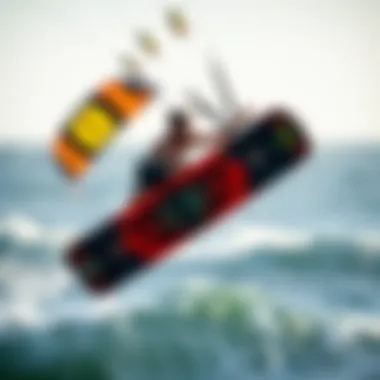
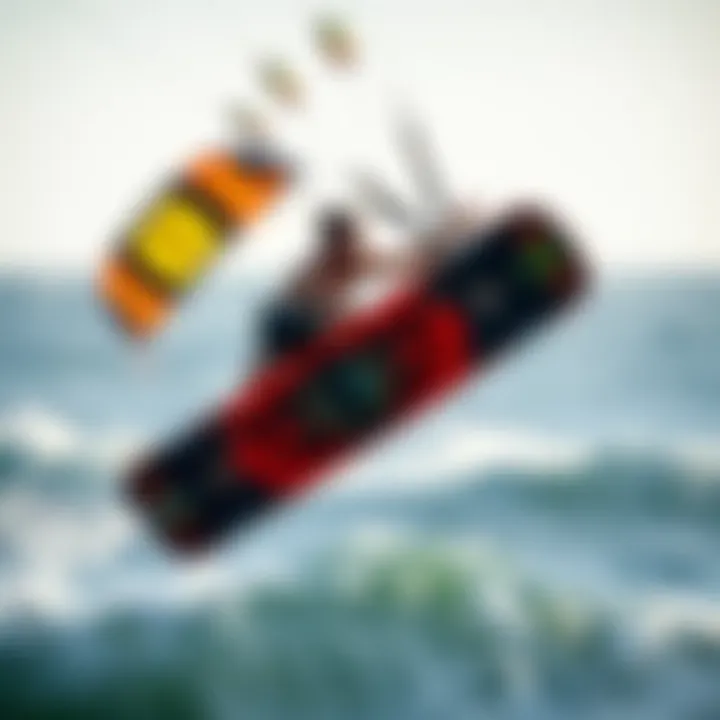
A good approach to mastering impact absorption is to practice landing on softer surfaces (like sand or grass) before progressing to water. This practice allows you to get a feel for the mechanics involved without the risks of falling in the water.
Maintaining Control After Landing
Once you’ve completed the landing, the work isn’t over—staying in control is the next challenge. Many kiteboarders find themselves tumbling after a successful jump due to the sudden shift in dynamics. To maintain control post-landing, keep the following in mind:
- Eyes Forward: Always look where you want to go, not where you don’t. This simple visual trick can guide your body and board in the desired direction.
- Body Position: Maintain a low stance after landing; your knees should stay bent. This position allows flexibility to react to any changes in the water or wind conditions.
- Kite Control: Keep an eye on your kite’s position. If it’s too low or high, it can affect your balance. Keeping it stable and mostly at a mid-range altitude will help you navigate effectively after landing.
Ultimately, practice is key. Regularly rehearsing landing fundamentals will help solidify control techniques, integrating them into your overall kiteboarding skillset, increasing not just your jumps but also your confidence.
Mental Preparation and Focus
In the realms of kiteboarding, where the thrill of soaring high above the waves meets the demands of precise technique, mental preparation is often the unsung hero behind remarkable performances. While physical conditioning and technical skills are key, the power of the mind in enhancing one's ability to jump higher and land safely cannot be overstated. Mental focus sets the stage for everything else—be it the initial takeoff, control mid-air, or a smooth landing.
The benefits of cultivating a strong mental state are manifold. Most importantly, a focused mindset fosters confidence, enabling kiteboarders to push their limits without hesitation. When worries about failure or the fear of falling creep in, they can overshadow even the most finely tuned techniques. By honing mental focus, kiteboarders can channel their energy into executing jumps rather than getting lost in self-doubt.
Additionally, mental preparation serves as a buffer against environmental variables, such as wind conditions, that may otherwise throw a rider off their game. The ability to maintain a positive mindset and adaptability is instrumental in overcoming challenges, allowing kiteboarders to stay calm and composed, even on blustery days.
Visualization Techniques
Visualization is a powerful mental training method used by athletes across disciplines. It involves imagining successful jumps in vivid detail before attempting them. By picturing every aspect—from the moment of takeoff to the thrilling height above the water, and the landing—riders can prepare their minds for execution.
Here’s how kiteboarders can effectively incorporate visualization into their routine:
- Create a Mental Movie: Before hitting the water, spend a few minutes visualizing the jump as if it were playing out on a screen. Include sensations, sounds, and visual details, creating a multi-sensory experience.
- Focus on Technique: Detail the specific techniques that contribute to a successful jump. This could include body position, kite handling, and line tension. The more precise the mental imagery, the better the execution will likely be in reality.
- Reinforce Positive Outcomes: Picture not just the jump but the successful landing. By mentally rehearsing landing sequences, riders build a sense of confidence and assurance in their capabilities.
Overcoming Fear of Heights
For many kiteboarders, the heights reached during jumps can invoke feelings of anxiety or fear. Navigating these fears is crucial for performance enhancement. Fear often stems from a lack of control and unfamiliarity with the sensation of altitude. Recognizing this is the first step toward conquering it.
There are several strategies to manage and eventually overcome these trepidations:
- Gradual Exposure: Start with smaller jumps and gradually increase height as confidence builds. This gradual exposure helps normalize the sensation of jumping higher.
- Breathing Techniques: Employing deep breathing can help calm nerves before attempting significant jumps. Inhale slowly through the nose and exhale through the mouth, slowing down the heart rate and centering focus.
- Mindfulness Practice: Incorporate mindfulness into kiteboarding practice sessions. Staying present and focused on the moment can reduce anxiety and help kiteboarders remain centered during high altitudes.
Building Confidence through Practice
Confidence doesn’t materialize overnight; it’s built step by step through consistent practice. Regular repetition solidifies techniques, allowing kiteboarders to establish muscle memory necessary for flawless jumps. Here are some practical approaches:
- Set Small Goals: Break down jumps into smaller, manageable goals. Instead of focusing solely on height, consider aiming for improved technique or smoother landings. Celebrate each achievement.
- Record and Review: Utilize video analysis to record jumps and assess performance. Observing one’s progress can reveal improvements that contribute to greater confidence, reinforcing the idea that skills are developing over time.
- Create a Supportive Environment: Surround yourself with fellow kiteboarders who can offer encouragement and constructive feedback. Share experiences, as community helps lift confidence levels well beyond individually faced challenges.
Practicing mental techniques in conjunction with the physical aspects yields an unmatched advantage in kiteboarding.
For further reading, consider exploring resources on psychology in sports at Wikipedia or join kiteboarding forums on platforms like Reddit.
Utilizing Equipment for Enhanced Performance
When it comes to kiteboarding, the equipment you choose can significantly influence your jumping performance. Selecting the right gear not only heightens your jumping ability but also ensures that you control and land effectively. The equipment's design, material, and specifications play a vital role in how you experience and enhance your skills on the water.
Choosing the Right Board
Picking the right board is akin to choosing the right shoes before a hike. It sets the stage for your aerial antics. A well-suited board offers stability and responsiveness, maximizing your jumping potential. Here are some key factors to consider when choosing a board for kiteboarding:
- Size: Larger boards generally provide better stability and floatation, helping you rise higher, especially in lighter winds. Conversely, smaller boards are more agile and tend to excel when you want to perform tricks.
- Shape: The board's shape affects how it cuts through the water and lifts off during jumps. Boards with sharper edges might generate better speed, while those with rounded edges can be more forgiving and easier to control.
- Flex: Boards with different flex patterns cater to varying riding styles. Stiffer boards provide stronger pop off the water, while more flexible boards are likely better for landing and absorbing shock.
"Your board is an extension of yourself; the better the fit, the higher you can fly."
Kite Selection for Jumping
When height is the goal, the kite you select can make all the difference. Not all kites are made alike, and understanding the dynamics behind each option can elevate your kiteboarding experience. Consider these factors:
- Kite Size: A larger kite catches more wind, which can offer a significant boost during jumps. However, if it’s too big, you may struggle to control it, especially while descending. A medium-sized kite tends to offer the best compromise between lift and handling.
- Kite Type: Different types of kites (like C-kites, delta kites, or hybrid kites) behave differently in terms of lift and speed. C-kites are known for their pop and tight turns but may not offer the same hang-time as others.
- Canopy Design: Kites with more pronounced curvature can provide better lift, which translates to higher jumps. Meanwhile, flatter kites may excel in speed but fall short on vertical performance.
Maintenance Tips for Gear Longevity
Taking care of your kiteboarding gear is as essential as selecting the right equipment in the first place. Regular maintenance not only extends the life of your gear, it also ensures that it performs optimally when you need it. Here are some simple maintenance tips:
- Rinse After Use: Saltwater can be harsh on your gear, so always rinse your equipment with fresh water after each session.
- Inspect Regularly: Look for wear and tear on your lines and kites. Any fraying or damage should be immediately repaired to avoid potential accidents.
- Store Properly: Keep your kite and board out of direct sunlight when not in use. UV rays can degrade materials over time. Store them in a cool, dry place.
- Follow Manufacturer Guidelines: Each piece of equipment comes with its own maintenance recommendations. Taking the time to understand these can save you headaches down the road.
By utilizing the right equipment, selecting the best boards and kites, and maintaining your gear, you set the foundation for improving your jumping ability in kiteboarding. With every detail considered, you can chase those heights confidently.
Common Mistakes to Avoid
When it comes to enhancing jumping ability in kiteboarding, avoiding certain pitfalls can make all the difference. Understanding common mistakes is crucial as it not only accelerates the learning curve but also minimizes risks associated with the sport. Many kiteboarders, especially those new to the sport, may overlook these aspects, thinking they can push through. The reality is, a few simple missteps can lead to poor performance and potential accidents. This section delves into specific errors that kiteboarders should steer clear of during their journey to mastering jumps.
Neglecting Warm-Up Exercises
Jumping into kiteboarding without a proper warm-up is akin to diving into a pool without checking the water level – it's risky. Warm-up exercises are vital for preparing the muscles and joints, ensuring flexibility and reducing the risk of injury. After all, kiteboarding is a physically demanding sport, and your body needs to be primed for the intense movements involved.
A good warm-up should include a blend of dynamic stretches and movements that mimic the actions you'll be performing on the water. Think about simple lunges, leg swings, and torso twists to start things off. Incorporating activities that activate the core is equally essential, as a strong core can significantly enhance your stability during jumps. Failing to warm up can lead to tight muscles and diminished performance, making those aerial maneuvers harder than they need to be.
Miscalculating Wind Conditions
Wind is the lifeblood of kiteboarding. Misjudging it can lead to challenging situations or even dangerous outcomes. Kiteboarders often focus primarily on their jumping techniques but can overlook the critical nature of wind conditions. Different jumps necessitate different wind strengths and directions.
Before venturing out, pay attention to local forecasts and even consult websites or apps that can provide real-time updates on wind conditions. Understanding whether you’re dealing with consistent winds or gusty conditions can significantly affect your jump height and stability.
For instance, in light winds, the kite may not generate sufficient lift, while high winds can push you too fast, giving little time for adjustments. It’s important to adapt your style and techniques based on these conditions. And remember, always err on the side of caution – if in doubt, a day spent learning in safer wind may do far more for your skills than forced jumps in unpredictable conditions.
Overexerting Before Mastering Basics
Sometimes the enthusiasm can carry kiteboarders away. You might be eager to get those high jumps under your belt, but overexertion without mastering basic skills is like trying to run before you can walk. It’s tempting to focus on the flashy moves, yet a solid foundation in basics like balance, control, and navigation plays a fundamental role in successful jumping.
A common approach is to break down the learning process into manageable chunks. Starting with simple maneuvers and gradually progressing to more complex jumps allows for proper muscle memory to develop. Rushing through could lead to sloppy technique, which not only impacts your performance but can also increase the risk of falls and injuries.
"Mastery takes time and patience. Build your skills step by step, and don’t let impatience lead you astray."
Incorporating Cross-Training Methods
Cross-training methods are crucial for kiteboarders looking to boost their jumping ability. This approach not only enhances physical performance but also minimizes the risk of injury by developing well-rounded strength, coordination, and flexibility. Focusing solely on kiteboarding can lead to muscle imbalances and overuse injuries, making it vital to incorporate diverse training activities into your regimen.
Benefits of Plyometric Training
Plyometric training is an explosive form of exercise that can greatly enhance a kiteboarder's jumping ability. By engaging in activities such as box jumps or depth jumps, riders can develop the fast-twitch muscle fibers necessary for powerful, high jumps.
- Increased Power Output: Plyometrics help in building the muscular force needed to propel oneself into the air.
- Improved Reaction Time: These exercises also improve the central nervous system's efficiency, allowing for quicker responses during jumps and landings.
- Heightened Endurance: Over time, this type of training can boost endurance by forcing the muscles to adapt to rapid contractions and recover quickly.
These benefits translate directly to better performance on the water. For kiteboarders, timing and power are everything—plyometric training sharpens both.
Agility and Balance Training
Agility and balance training forms another integral component of cross-training methods. Activities like ladder drills, cone drills, and specific balance exercises foster the coordination needed for stable landings and mid-air maneuvers.
- Enhanced Coordination: Balancing exercises improve the body's ability to control its movements and center of gravity.
- Dynamic Stability: Increased agility allows kiteboarders to make quick adjustments mid-jump, ensuring control when landing.
- Reduced Injury Risk: Enhancing balance can help prevent falls and missteps, reducing the chances of injury on the water.
Incorporating agility and balance drills into your workouts ensures that you maintain stability and finesse, especially when tackling more complex jumping techniques.
The Role of Flexibility in Jumping
Flexibility is often underestimated in its contribution to overall jumping ability. A flexible body can help kiteboarders execute smoother, more efficient movements during jumps. Key elements include:
- Joint Mobility: Flexibility allows for a greater range of motion, enabling kiteboarders to position their bodies optimally during takeoff and landing.
- Reduction in Muscle Tension: Less tension in muscles can lead to better power output. Stretching can help maintain and enhance this flexibility.
- Recovery Improvement: Regular flexibility training can enhance recovery times, allowing for more effective training sessions.
To enhance flexibility, consider incorporating yoga or dedicated stretching routines into your training schedule. A supple body is beneficial not just for jumps but for overall performance on the water.
"Flexibility is the key to effective movement whether you're smashing jumps or riding waves."
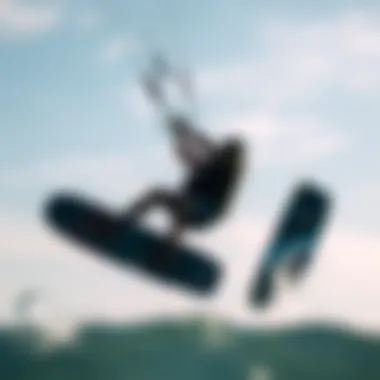
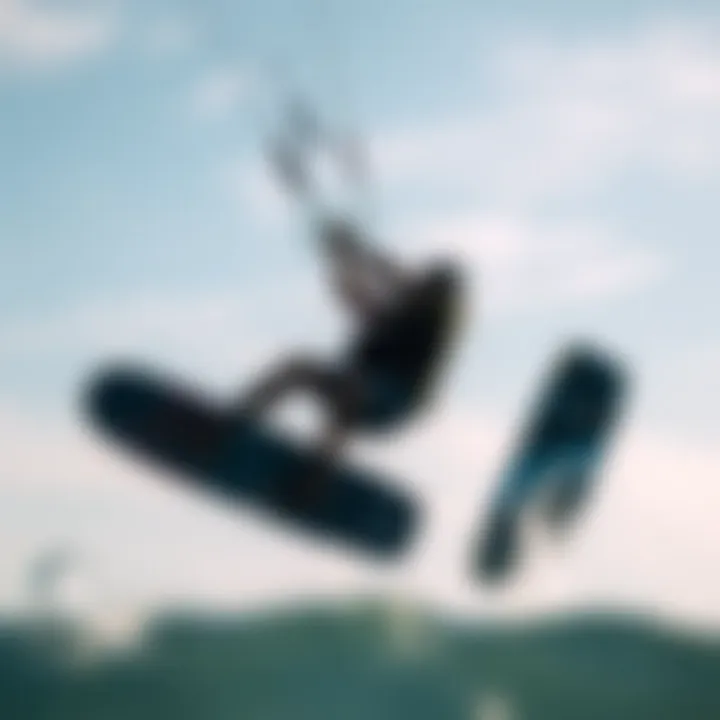
In summary, incorporating cross-training methods not only cultivates a more versatile skill set but actively promotes safety and performance in kiteboarding. By integrating plyometric training, agility and balance exercises, and flexibility routines, kiteboarders can set themselves up for success and reach new heights.
Setting Realistic Goals
Setting realistic goals in kiteboarding is akin to laying down the first brick on a sturdy path to success. This foundational element shapes not only your approach to jumping but also influences how you perceive your progress. Without having concrete and attainable goals, it’s easy to get lost in the vast ocean of possibilities, leading to frustration or disappointment. Here, we delve into the various facets of goal-setting and its pivotal role in enhancing your jumping ability.
Defining Progress Milestones
Progress milestones are the stepping stones on your road to improvement. They help keep your spirits high and your focus sharp. When defining these milestones, it’s crucial to break your end goals into smaller, more manageable bites. Here are some aspects to consider when establishing these benchmarks:
- Jump Height: Set specific height goals. If you currently jump two meters, perhaps aim to reach two and a half meters in three months.
- Aerial Control: Aim to enhance your aerial maneuvers. You might decide to master one new trick every month, gradually stacking them up.
- Technique Refinement: Maybe you wish to focus on perfecting your takeoff technique before adding variations to your jumps.
By segmenting your overall aim into these defined checkpoints, you set yourself up for success and make it easier to track your growth.
Monitoring Performance Improvement
Once your milestones are in place, effective monitoring becomes essential. You can’t improve what you don’t measure. Using a journal to record your sessions can offer significant insights. Here are some aspects to track:
- Jumps Executed: Document how many jumps you complete in each session. This quantifiable data helps you assess improvement trends.
- Height Achieved: Keep a log of the maximum heights reached during your sessions.
- Technique Observations: Note any challenges faced, such as difficulty in landing or unstable aerial position.
By consistently analyzing this performance data, you maintain a transparent view of your progression pace, allowing for timely adjustments to your training regime.
Creating an Action Plan for Development
An action plan is your roadmap; it tells you where you’re going and how you will get there. Start by identifying the key skills required for better jumping. This may involve:
- Strength Training: Schedule strength workouts focusing on the muscles crucial for jumping higher.
- Technique Drills: Incorporate specific drills that help refine your takeoff and landing mechanics on a weekly basis.
- Feedback and Adjustment: Seek constructive feedback either from fellow kiteboarders or instructional resources you trust. Be open to refine your technique accordingly.
Example of an Action Plan:
- Week 1-2: Focus on strength training sessions thrice a week, emphasizing leg and core muscles.
- Week 3-4: Dedicate sessions to refining jump technique, practicing at least two specific drills per session.
- Ongoing: Keep seeking feedback from knowledgeable peers and adapt your techniques based on their suggestions.
With clear, realistic goals and a solid action plan, achieving greater heights in kiteboarding is not just a distant dream, but an exciting journey waiting to unfold.
In summary, setting realistic goals in kiteboarding is about establishing a clear vision for your development. It’s essential to define progress milestones, track your improvement accurately, and craft actionable plans to foster continuous growth. By putting these strategies into practice, you’re setting the stage for not just successful jumps, but also a comprehensive enhancement of your skill set.
Role of Community and Support
In the kiteboarding world, having a solid support system can be the wind in your sails. Community plays a significant role in enhancing the jumping ability of kiteboarders, whether they're just diving into the sport or honing advanced skills. Engaging with others, sharing experiences, and learning from each other can make a world of difference in safety, confidence, and performance.
Engaging with Fellow Kiteboarders
Meeting fellow kiteboarders can bring a multitude of benefits. When you connect with others who share the same passion, you create an environment where knowledge and skills can flow seamlessly. Engaging with this community helps you:
- Share Techniques: Fellow riders can introduce you to new ways of jumping or edge control that may not be in the textbooks.
- Boost Confidence: Watching others jump and seeing your progression can ease nerves, making it easier to push past your limits.
- Encourage Safe Practices: Experienced kiteboarders often know the ins and outs of safety, helping you avoid common pitfalls.
By having this social network, whether at the beach or a local club, you can tap into a wealth of firsthand knowledge that can help elevate your skills.
Participating in Workshops and Clinics
Workshops and clinics are another fantastic way to enhance your jumping prowess. Organized events, often run by seasoned instructors, provide focused training that is tailored to specific skills. These sessions allow for:
- Hands-On Instruction: You often get immediate feedback while practicing new techniques, allowing for quick adjustments.
- Structured Learning: Many clinics focus on particular aspects of kiteboarding, such as jumping techniques or landing strategies.
- Networking Opportunities: You might meet mentors who can continue guiding your progress long after the events.
Investing time in these structured settings can provide insights you’d be hard-pressed to find alone.
Online Resources and Forums
The internet is a treasure trove of information for kiteboarders, making it easier than ever to learn and improve. Online forums and resources foster a sense of community even when you’re miles away. Getting involved in these platforms allows:
- Access to Expertise: Many experienced riders share tips, tricks, and sometimes even video tutorials.
- Real-Time Advice: Forums like Reddit or specific kiteboarding groups on Facebook can provide instantaneous feedback on your questions.
- Updates on Events/Meetings: You can easily find local meet-ups, workshops, or clinics being organized, ensuring you never miss an opportunity to grow.
By utilizing online resources, you can keep your finger on the pulse of the kiteboarding community, which is crucial for both learning and motivation.
Important Note: "The most profound learning often comes not just from individual practice, but from interaction and shared experiences with others in the sport."
Experimenting with Different Styles
Experimenting with various styles in kiteboarding can be a real game changer. It stretches the limits of your capabilities and allows you to discover unique maneuvers that work best for your skills and comfort level. While sticking to conventional techniques can yield good results, stepping outside the box can elevate your performance and keep the thrill alive.
Diverse jumping styles offer numerous advantages, from improved maneuverability to enhanced aerial displays. Trying new approaches keeps the sport invigorating, allowing kiteboarders to adapt to changing conditions and pushing their performance further.
Varied Jump Techniques
Varied jump techniques are essential for any kiteboarder looking to improve their aerial tricks. Simple jumps can evolve into complex flips or rotations with the right adjustments in style.
- Pop Jump: Using a quick edge change to hit the water and propel upwards, this technique is perfect for those just starting.
- Heelside Jump: Perform this by engaging your heels and maintaining a low center of gravity. It allows for sharper turns and tricks.
- Toeside Jump: This one provides a different feel, as you shift weight onto your toes, generating a unique lift and duration in the air.
Each jump technique comes with its own flavors. They are not just about reaching greater heights; they pertain to style and artistic expression in your approaches. As you experiment, you may find that certain techniques produce lifts better suited for specific wind conditions or equipment.
Dynamic vs Static Jumps
When comparing dynamic and static jumps, it’s crucial to understand the feelings they evoke and their applications in kiteboarding. Dynamic jumps stem from a sense of movement and thrill, often utilizing the kite's power and harnessing the wind to elevate beyond the average height. Static jumps, on the other hand, occur more from stability and control. You lean more into the air rather than pushing against it, which provides a grounded takeoff.
- Dynamic Jumps: Require speed and power, often involving full-body engagement to generate lift. These jumps tend to be more visually impressive and offer greater height.
- Static Jumps: Here, the focus shifts to technique. Riders maintain their body position while using subtle movements to execute tricks. This style is all about control and landing accuracy.
Balancing these styles is key. Mastering the art of each will allow you to not only gain height but also land with finesse. The more adept you become at switching between these styles, the more noticeable improvements you’ll see in your kiteboarding.
Analyzing Jump Styles from Pros
Taking a lesson from the best in the game can unlock a treasure trove of insights. Analyzing the jump styles of professional kiteboarders helps identify critical components of their techniques. Often, these pros have honed their style through years of practice and experience.
When observing a professional:
- Body Alignment: How does their stance shift during different jumps? Balance is paramount.
- Kite Position: How high or low is their kite during takeoff? That can make a huge difference in performance.
- Edge Control: Watch how they manipulate their edges just before the launch. This aspect can provide a significant burst of speed.
By videoing their practices and analyzing their techniques on platforms like Reddit or watching tutorials on YouTube, here are some highly recommended sessions:
- Twintip Jumps
- Board-Off Tricks
- Backrolls and Frontrolls
Through these observations and experiments, you can adapt what resonates with your style. Remember, it’s all about finding your voice on the water while pushing your limits.
Nutritional Considerations for Performance
In kiteboarding, every bit of energy counts, especially when it comes to executing those awe-inspiring jumps that set the stage for a thrilling session on the water. The fuel you provide to your body plays a crucial role not only in your overall performance but also in your post-session recovery. Understanding the intricacies of nutrition can significantly enhance your jumping ability, foster endurance, and promote quicker recovery after an exhilarating day out on the waves.
Importance of Hydration
Staying properly hydrated before, during, and after kiteboarding is non-negotiable. The body loses fluids rapidly through sweat, particularly in the warm sun or windy conditions typical for this sport. Dehydration can lead to decreased physical performance, fatigue, and reduced mental focus, which are detrimental when you’re trying to nail those jumps. Even mild dehydration can hinder your muscular response and overall energy levels, which is the last thing a kiteboarder wants.
It's recommended to drink water consistently throughout the day, not just during your session. Adding electrolyte-rich drinks can also be beneficial, particularly after intense sessions, as they help restore the minerals lost through sweat.
Pre- and Post-Session Nutrition
What you eat can make or break your kiteboarding performance. Before hitting the waves, a meal rich in carbohydrates is crucial. This could be as simple as a banana or a bowl of oatmeal. Carbs provide the quick-release energy that powers you through your jumps. Try to eat your pre-session meal a couple of hours prior to ensure your body has ample time to digest. Avoid heavy meals that might weigh you down or cause discomfort.
Post-session nutrition is equally important. After a day of kiteboarding, your muscles demand replenishment. A meal that combines protein and carbohydrates will help you refuel and kickstart recovery. Think of grilled chicken with quinoa or a smoothie with Greek yogurt and fruit. Avoid hitting the junk food right away, even if it seems tempting. Your body will thank you in the long run by bouncing back quicker for the next session.
Supplements for Enhanced Recovery
While it’s always best to derive nutrients from whole foods, sometimes it’s practical to incorporate supplements to aid recovery. Protein powders, for example, can be particularly useful for those on-the-go moments when you may not have the time for a full meal. In addition, omega-3 fatty acids can help reduce inflammation in muscles and joints, another bonus for kiteboarders who push their limits regularly.
Other common supplements like branched-chain amino acids (BCAAs) can assist in muscle recovery post-activity. Another key player is magnesium, which can help prevent muscle cramps and fatigue. Lastly, don’t overlook Vitamin D and Calcium for bone health, important for anyone engaging in high-impact sports.


"Good nutrition is key for kiteboarders seeking to optimize performance and maintain energy during demanding sessions."
Remember, a thoughtfully crafted nutrition plan that pairs well with the demands of kiteboarding can not only enhance your jumping ability but also enable you to enjoy the sport longer and at a higher level. Each bite, or sip, is investment in your success on the water.
Analyzing Successful Kiteboarders
Examining the techniques of respected kiteboarders can serve as a goldmine of knowledge for anyone looking to elevate their jumping abilities. Each accomplished kiteboarder provides a unique perspective on what it takes to soar through the skies, making it essential to analyze their approaches and the strategies they employ. This process is not merely about copying styles, but rather about dissecting what makes them effective and adaptable to one's own technique.
Through case studies of top jumpers, we gather insights into different techniques and styles, potentially sparking new ideas or even monumental changes in how one approaches jumping. This method of learning can serve to inspire kiteboarders to experiment and think critically, essential attributes within this sport that thrives on innovation.
Case Studies of Top Jumpers
Taking a closer look at champions of the sport, such as Aaron Hadlow or Graham Ezzy, reveals countless elements contributing to their prowess. For instance, Hadlow’s approach incorporates specific methods that link body mechanics with kite manipulation, yielding extraordinary results in height and control. Similarly, Ezzy’s grounded technique emphasizes the importance of proper ommon maneuvers that keep him stable and balanced mid-air. Whether it is studying their videos or receiving personal lessons, understanding these athletes' trajectories offers valuable takeaways for kiteboarders.
To unpack the significance of their achievement, observe:
- Aaron Hadlow: Known for his innovative tricks, he emphasizes timing and the manipulation of wind by focusing on acceleration during takeoff.
- Graham Ezzy: His technique illustrates the merit of smooth transitions and adaptive strategies tailored for varied wind conditions.
Both athletes verify that a combination of these attributes is what permits them to reach heights that lesser-known riders often struggle to achieve.
Lessons Learned from Their Techniques
The takeaway from studying elite kiteboarders should not just be limited to techniques, but also delve into their mindset. Here are several concepts that can be extracted from analyzing their methods:
- Attitude towards Risk: Top kiteboarders often assess and take calculated risks, pushing boundaries that result in impressive feats.
- Continuous Learning: They are never done learning—even the best constantly refine their craft.
- Mental Resilience: The ability to stay calm in unpredictable situations can set apart an average kiteboarder from a legend.
These lessons encourage kiteboarders to focus on adapting rather than merely imitating, shifting the focus to what can be uniquely applied in their own sequences.
How to Adapt Their Strategies
Adapting the techniques of successful kiteboarders doesn’t mean blindly copying their movements. It involves experimenting and modifying established methods to suit personal strength, style, and local conditions:
- Strength and Flexibility Training: Emulate their physical conditioning routines but tailor them to one’s own limitations and requirements.
- Video Analysis: Capture your own jumps and compare them against those of the pros. Identifying what works can help you refine your own performance.
- Find Your Own Style: Use insights as a foundation for developing techniques that feel natural to you.
Ultimately, it’s about building a bridge between learned techniques and your established skills. By respecting what worked for others but remaining open to unique adaptations, you’ll find a greater sense of personal accomplishment in each jump.
Analyzing successful kiteboarders provides not only a roadmap for improvement but motivates kiteboarders to think critically about their own practices. The journey toward mastering jumps is continuous, filled with opportunities to learn from those who have paved the way.
Evaluating Equipment Performance
Evaluating your equipment's performance is pivotal in kiteboarding, especially when it comes to enhancing jumping ability. Having the right setup can make the difference between a breathtaking leap and a less than graceful landing. An effective evaluation leads you to choose the right gear tailored to your skill level and the conditions you face, which is essential for maximizing your performance.
Understanding Different Board Designs
Kiteboards come in various designs, and each can significantly impact your jumping ability. Knowing how to differentiate between them is crucial.
Some boards are designed for specific styles, such as freestyle, freeride, or wave riding. Freestyle boards, for example, often feature a flatter rocker to facilitate easier pop-off the water during jumps. Meanwhile, boards with more rocker can help in conditions with powerful waves but may sacrifice some lift. The material used in construction also matters. A lightweight board offers better aerodynamics and thus, a more heightened jumping experience.
When selecting a board, consider the following elements:
- Shape: A wider board generally provides more surface area, enhancing stability during takeoff.
- Flexibility: A stiffer board may translate to better performance in higher speeds, while a more flexible board offers comfort during landings.
- Size: Seasonal changes and body weight influence the type of board that suits best.
The Impact of Kite Size on Jumping
The kite you choose has a significant bearing on how high and effectively you can jump. Kite size directly influences lift—larger kites offer more power but may be harder to control in strong winds.
Here’s what to consider:
- Windspeed: In lighter winds, a larger kite can generate more lift, thus facilitating higher jumps. Conversely, in stronger winds, using a smaller kite allows for quick movements and better maneuverability but may not provide as much lift.
- Experience Level: As a beginner, it's advisable to start with a more controllable kite size. As you progress, experimenting with different sizes can help you find that sweet spot that maximizes your efficiency.
- Jump Styles: Depending on whether you prefer dynamic jumps or more static ones, your kite size should align with your technique to optimize performance.
Maintenance Strategies for Optimal Function
Ensuring that your equipment remains in top shape only enhances performance and makes it safer to pursue your passion. Here are some strategies:
- Regular Inspection: After each session, check for damages or wear and tear, particularly on the lines and seams of the kite.
- Cleaning: Make it a habit to rinse your kite and board with fresh water post-session to prevent salt accumulation and prolong longevity.
- Proper Storage: Store your gear away from direct sunlight and moisture. A dry, cool area prevents degradation and maintains performance quality.
- Lines Alignment: Ensure that your lines are untangled and positioned correctly. Misaligned lines can hinder your jumps and cause equipment malfunctions.
"Proper maintenance is not just an afterthought; it’s a season-long commitment for peak performance."
Safety Considerations When Jumping
Jumping in kiteboarding, while exhilarating, comes with its share of risks. Ensuring safety is as crucial as mastering your skills. Being aware of potential hazards and understanding how to mitigate them can significantly enhance your overall experience on the water. The good news is that with the right knowledge, kiteboarders can truly enjoy the thrill of soaring without compromising their safety.
Understanding Weather Conditions
Before even thinking about jumping, it’s essential to grasp how weather affects your kiteboarding session. Conditions like wind speed, direction, and temperature can dictate not only the feasibility but also the safety of your jumps.
- Wind Speed: A gusty wind can be a kiteboarder's best friend or worst enemy. Too much wind can lift you too high and make control difficult, leading to hard landings. Conversely, too little wind can leave you grounded, increasing the risk of colliding with water or even coming up short on your jumps.
- Weather Patterns: Familiarize yourself with local weather patterns. Sudden changes can occur, turning a perfectly safe outing into a hazardous one. If you see dark clouds rolling in, it’s a signal to pack it up and head for shore.
- Temperature: Extreme temperatures can affect both your physical performance and the functionality of your gear. Cold weather can numb your senses and slow reaction times, while hot weather can lead to fatigue and dehydration.
It’s crucial to always check forecasts and be prepared for changes. Using reliable apps and websites that specialize in wind and weather can help you stay informed. Always err on the side of caution; if you feel the weather might not be in your favor, it’s better to skip the jumps for that day.
Personal Protective Equipment
Using personal protective equipment (PPE) can dramatically reduce the risk of injury when kiteboarding. Many novice kiteboarders underestimate the importance of proper gear. Here are some must-haves:
- Helmet: Protecting your head should be non-negotiable. A good quality helmet can save your life in case of a fall or collision.
- Impact Vest: An impact vest provides protection for your torso and can help absorb shock during a hard landing. Some vests even include flotation, which is beneficial if you find yourself in the water unexpectedly.
- Wetsuit: Not only does a wetsuit keep you warm, but it can protect your skin from scrapes and the sun.
- Footwear: While some prefer to go barefoot, a good pair of booties can protect your feet from cuts or scrapes, especially if you encounter rocks or barnacles during landings or crashes.
Investing in quality PPE is essential. It's the difference between a minor scare and a major injury. Always inspect your equipment regularly for any defects or wear and tear.
Emergency Procedures while Jumping
The unpredictability of kiteboarding makes it imperative to have a clear set of emergency procedures in place before you engage in jumping. Knowing what to do in various emergency situations can be the hallmark of a responsible kiteboarder.
- Have a Buddy System: Always kite with a partner. Should anything go awry, having someone nearby can be a lifesaver. Agree on signals to indicate if you need help.
- Know How to Self-Rescue: Familiarizing yourself with self-rescue techniques prior to going out can save valuable moments when things go south. Practice these techniques in calm conditions so you’re prepared during high-stress situations.
- Emergency Contacts: Always have a way to communicate with emergency services, and know the nearest locations for help. A waterproof phone case might just be your best friend out on the water.
Educating yourself on these safety measures is not just prudent; it is essential for safe riding and enjoying the sport to its fullest potential. Remember, you can never be too prepared when it comes to safety in kiteboarding. Navigating the skies should always be thrilling, yes, but with every leap into the air, a staunch foundation of safety is what keeps you grounded.
Always prioritize your safety and the safety of others when on the water. Learn, adapt, and elevate your kiteboarding experience while keeping risks at bay.
Continuous Improvement and Adaptation
In the world of kiteboarding, the journey to enhance jumping ability is never truly complete. Continuous improvement and adaptation is the essence that keeps kiteboarders striving for greater heights, literally and figuratively. This process not only involves honing physical skills but also tuning mental attributes and adapting to ever-changing conditions on the water.
The importance of this topic is manifold. Initially, kiteboarders often experience plateaus where progress seems stuck. Evaluating one's performance regularly can uncover unnoticed flaws or habits that hinder advancement. This evaluation isn't just about tracking jump height; it's about analyzing every facet of your technique. Are there moments in your takeoff where tension fails? Is your landing stance consistently stable? These questions become crucial in finding room for growth.
Additionally, learning to adapt plays a vital role in sustaining long-term improvement. Kiteboarding is heavily influenced by wind conditions, water state, and myriad external factors. Adjusting techniques based on real-time feedback not only raises performance but ensures safety as well. Understanding how to read the environment is as critical as mastering the kite itself.
Lastly, being open to change reflects a growth mindset. Many times, practitioners cling to techniques and equipment that may not cater to their evolving skills.
"A ship is always safe at shore, but that’s not what it’s built for."
Taking calculated risks and innovating with new techniques or gear can reinvigorate performance and bring about impressive results.
Evaluating Personal Progress
Understanding how to measure one's advancement is crucial. Here are aspects to consider for evaluating personal progress:
- Set Specific Goals: Instead of vague targets like "jump higher," define milestones with clear criteria, like achieving a certain height or mastering a specific maneuver.
- Self-Assessment Videos: Recording your sessions can serve as a rich resource for identifying areas that need attention or adjustment. Seeing your performance can offer insights that might be overlooked in real-time.
- Performance Journals: Keeping a record of sessions can help track progression, noting wind conditions, techniques attempted, and feelings surrounding specific jumps. Over time, patterns will emerge that may highlight progression or areas needing focus.
Staying Informed on Industry Trends
The kiteboarding world is ever-evolving, and being on top of the latest trends can be a game-changer:
- Follow Reputable Sources: Websites like Reddit and dedicated forums provide updates on the latest gear, techniques, and tips from experienced riders.
- Engage with the Community: Connecting with other kiteboarders through social media platforms or local meetups fosters learning and camaraderie. Learning from others’ experiences can provide fresh perspectives.
- Attend Workshops and Clinics: Participating in skill development events not only enhances technique but also exposes you to innovative practices from seasoned riders and coaches.
Embracing Change in Technique and Equipment
When it comes to kiteboarding, stagnation can be the enemy. Embracing change is essential for continuous improvement. Here are a few considerations:
- Experiment with Gear: Don’t shy away from trying new boards, kites, or accessories. What worked for you before may not be the best fit as your skills develop.
- Adapt Techniques for Conditions: Wind and water conditions vary; adaptability in your approach can lead to significant breakthroughs. Whether it’s altering your stance or tweaking your jump timing, learning to adjust your technique offers the path to better performance.
- Stay Open to Critique: Accept constructive feedback from peers or instructors. Sometimes, an outsider's perspective can highlight overlooked issues in technique that, when corrected, can lead to rapid improvement.
By fostering an environment of continuous improvement and adaptation, kiteboarders can sustain their development journey whilst navigating through the dynamic conditions of the sport. The sky truly is the limit, and the thrill of improvement keeps the passion of kiteboarding alive.

